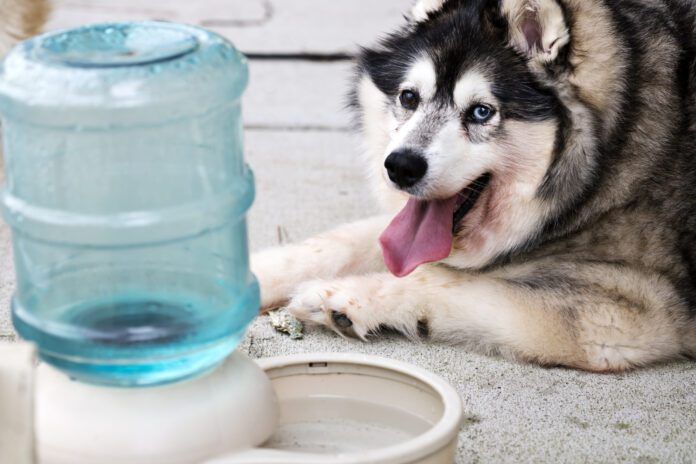Cushing’s disease in dogs, also known as hyperadrenocorticism (HAC), is a syndrome that occurs when the dog’s body is under the influence of too much steroid, whether it be natural steroid produced in the body or steroid medications that were administered to treat another condition.
The most common symptoms of Cushing’s disease in dogs include:
- Excessive thirst (polydipsia)
- Excessive urination (polyuria)
- Excessive hunger and eating (polyphagia)
- Excessive panting
- Muscle weakness
- Abdominal distension (“pot-bellied appearance”)
- Thinning hair coat or balding (alopecia)
- Slow hair regrowth
- Thin skin
- Blackheads (comedones)
- Lethargy
In addition to these symptoms, dogs with Cushing’s disease are prone to high blood pressure (hypertension), urinary tract infections, chronic skin infections, concurrent diabetes, thick skin plaques called calcinosis cutis, and blood clots (thromboembolism). Because ligaments become weaker, anterior cruciate ligaments (ACLs) in the knee may tear or rupture. Stomach ulcers may eventually develop in untreated dogs.
Fortunately, Cushing’s tends to be quite slowly progressive, so it will likely be months, or even years, before a dog with the syndrome suffers many of these symptoms.
Adrenal function needs to be just right
Natural steroids, also known as glucocorticoids or cortisol, are essential hormones produced by the adrenal glands that play a role in metabolism, immunity, the stress response, and other important bodily functions. Underactive adrenal glands, producing too little steroid, create a life-threatening condition called Addison’s disease in dogs. Overactive adrenal glands, producing too much steroid, results in Cushing’s disease in dogs. Life is definitely best when adrenal function is just right!
The preferred term for Cushing’s disease or hyperadrenocorticism in dogs is “Cushing’s Syndrome,” as Cushing’s is complicated, with four different types all causing the same set of symptoms:
- Pituitary-dependent hyperadrenocorticism (PDH). This is the most common form of Cushing’s disease in dogs, responsible for 85% of cases. It is caused by a tumor (usually benign) in the pituitary gland creating too much adrenal-stimulating hormone, which then results in overproduction of cortisol by the adrenal glands. Since the pituitary gland is very close to the brain, occasionally neurologic derangements can occur, depending on the size and type of tumor.
- Adrenal tumor. This type of HAC happens when a primary functional tumor forms in an adrenal gland, resulting in overproduction of cortisol.
- Iatrogenic HAC. This is caused by administration of steroid medication, either oral or topical, and is clinically indistinguishable from naturally occurring Cushing’s disease.
- Atypical HAC. This happens when a missing enzyme results in build up of cortisol precursors (sex hormones) resulting in the exact same symptoms as all the other forms of HAC.
Diagnosis for Cushing’s
No test for Cushing’s disease in dogs is perfect, but the one most heavily relied upon is called the low dose dexamethasone suppression test (LDDST). This is a “challenge” test, where the dog is given a dose of intravenous steroid, and its response to that challenge is measured. Due to the negative feedback systems responsible for maintaining balance in the body, a normal dog’s natural cortisol production will be suppressed when the brain recognizes extra steroid in circulation. But if a dog has Cushing’s disease, his overactive adrenal glands don’t have the capacity to suppress their cortisol production.
This test requires an 8-hour stay in the hospital, with a baseline blood sample drawn before the steroid is injected, and additional samples drawn at four hours and eight hours post-injection. Dogs without Cushing’s disease will have very low cortisol levels at four and eight hours. Dogs with Cushing’s disease will still have elevated cortisol levels at four and eight hours, since they are unable to suppress cortisol production.
The LDDST test can be a bit pricey. There is a less expensive, less invasive preliminary screening test you can do first, in hopes of avoiding the cost and stress associated with the LDDST. It is called a urine cortisol:creatinine ratio (UCCR) test. It is performed on a urine specimen you catch at home during a time of low or no stress for your dog (stress results in false positive results). And here’s the deal: If the UCCR test is normal your dog does not have Cushing’s disease. However, if the UCCR test result is abnormal, it means only that your dog might have Cushing’s, and you need to go forward with the LDDST after all.
Determining the type of Cushing’s
Once your dog has been diagnosed with Cushing’s disease, the next step is to determine whether it’s PDH or an adrenal tumor. While there are additional blood tests that can be performed, most clinicians recommend an abdominal ultrasound as the next step. With PDH, both adrenal glands are typically symmetrically enlarged. With an adrenal tumor, one adrenal gland is usually enlarged by tumor, and the opposite gland is small. Ultrasonography can often identify neoplastic (cancerous) changes in the architecture of the affected gland as well.
For iatrogenic Cushing’s, a good history is of the utmost importance. Is the dog taking oral steroids? Is topical cortisone being applied chronically for dermatologic disorders? Is the dog owner (or someone else in the household) using topical cortisone products on themselves that the dog may be licking? To confirm iatrogenic Cushing’s disease, an Adrenocorticotrophic Hormone Stimulation Test (ACTH Stim) must be performed. This is another “challenge” test. This time, a baseline blood sample is drawn, and ACTH is injected, with a post-injection sample drawn one to two hours later. Dogs with either normal adrenal glands, or PDH or AT, will show a spike in cortisol production after this adrenal stimulation. If the symptoms and history fit, and the ACTH Stim shows no spike in cortisol levels, iatrogenic Cushing’s is the diagnosis and the external source of steroid needs to be slowly withdrawn. Slow withdrawal is important, as the adrenal glands will have become a bit sleepy since there’s been plenty of steroid floating around, and they need time to ramp back up to full function.
If all of this isn’t complicated enough, let’s talk about Atypical Cushing’s disease. These dogs have all the symptoms of Cushing’s Syndrome but their diagnostic tests all come back normal. When this happens, the final stone to overturn is to test for Atypical Cushing’s, which requires an ACTH Stim test with measurement of sex hormones before and after stimulation. A spike in sex hormones after ACTH stimulation is indicative of Atypical Cushing’s.
Treatment for Cushing’s
Because Cushing’s disease progresses so slowly, some veterinarians and pet owners will opt not to treat until the dog’s symptoms become problematic. As long as you and your veterinarian monitor your dog’s health closely this is an acceptable approach early in the course of the disease.
Trilostane has become the treatment of choice for PDH. It is a synthetic steroid equivalent that inhibits an enzyme, resulting in suppression of natural cortisol production. Side effects are generally mild (lethargy, vomiting, diarrhea) but careful monitoring is important, as too much trilostane can cause excessive adrenal suppression, which can be deadly. Monitoring requires repeat ACTH Stim tests at the intervals recommended by your veterinarian.
Mitotane (Lysodren) is another treatment for PDH that actually destroys adrenal tissue, thereby decreasing the amount of cortisol that can be produced. Side effects may be mild or severe, and include weakness, vomiting, diarrhea, and loss of appetite. Treatment with Lysodren also requires close monitoring with repeat ACTH Stim tests as inadvertently destroying too much adrenal tissue creates a potentially life-threatening situation, and the damage may be irreversible.
Radiation therapy can be considered for dogs with large pituitary tumors causing neurologic impairment.
For atypical Cushing’s disease, Lysodren is the treatment of choice as it suppresses the sex hormones as well as cortisol. Trilostane does not.
The treatment of choice for an adrenal tumor is surgical removal of the abnormal adrenal gland (unilateral adrenalectomy). This is unfortunately a difficult surgery with the possibility of severe complications (hemorrhage, thromboembolism) both during the procedure and after. The best candidates for surgery are dogs with small tumors with no evidence of tumor invasion into surrounding blood vessels and no evidence of cancer spread to liver or lungs (metastasis).
For dogs who are not candidates for surgery for whatever reason, palliative therapy with Trilostane or Lysodren can help. Radiation therapy is another option for these dogs.
If these treatments and their associated hazards have you shaking in your boots, supplements of melatonin and lignans are a couple of alternative treatments you can try. These are less noxious for sure, but unfortunately also less effective.
Melatonin is a neurohormone produced by the pineal gland; it inhibits certain enzymes resulting in decreased cortisol production. Flaxseed oil with lignans has anti-estrogen activity so may be useful for Atypical Cushing’s disease. Melatonin and lignans can be used together.
You may read about ketoconazole and selegiline (Anipryl) as alternative treatments for Cushing’s disease. The word on these, however, is that their efficacy is so low you’d really just be wasting your time and money.
Time to think it over
As you can see, Cushing’s disease in dogs is complicated. Treatment options can be scary. The expense associated with treatment and the necessary monitoring adds up quickly. The upside is that Cushing’s disease is typically so slowly progressive that dogs can live with it for a long time before it causes problems. If your dog is diagnosed with Cushing’s disease, talk to your veterinarian about what may be the best option for you and your dog. To treat or not to treat? If treating, which treatment? If not treating, how can you carefully monitor your dog’s health while living with Cushing’s disease? Frequent physical examinations, blood work, urinalysis and blood pressure measurement should be considered. These are all important details that must be given serious consideration in order to make the best decisions for your dog.






